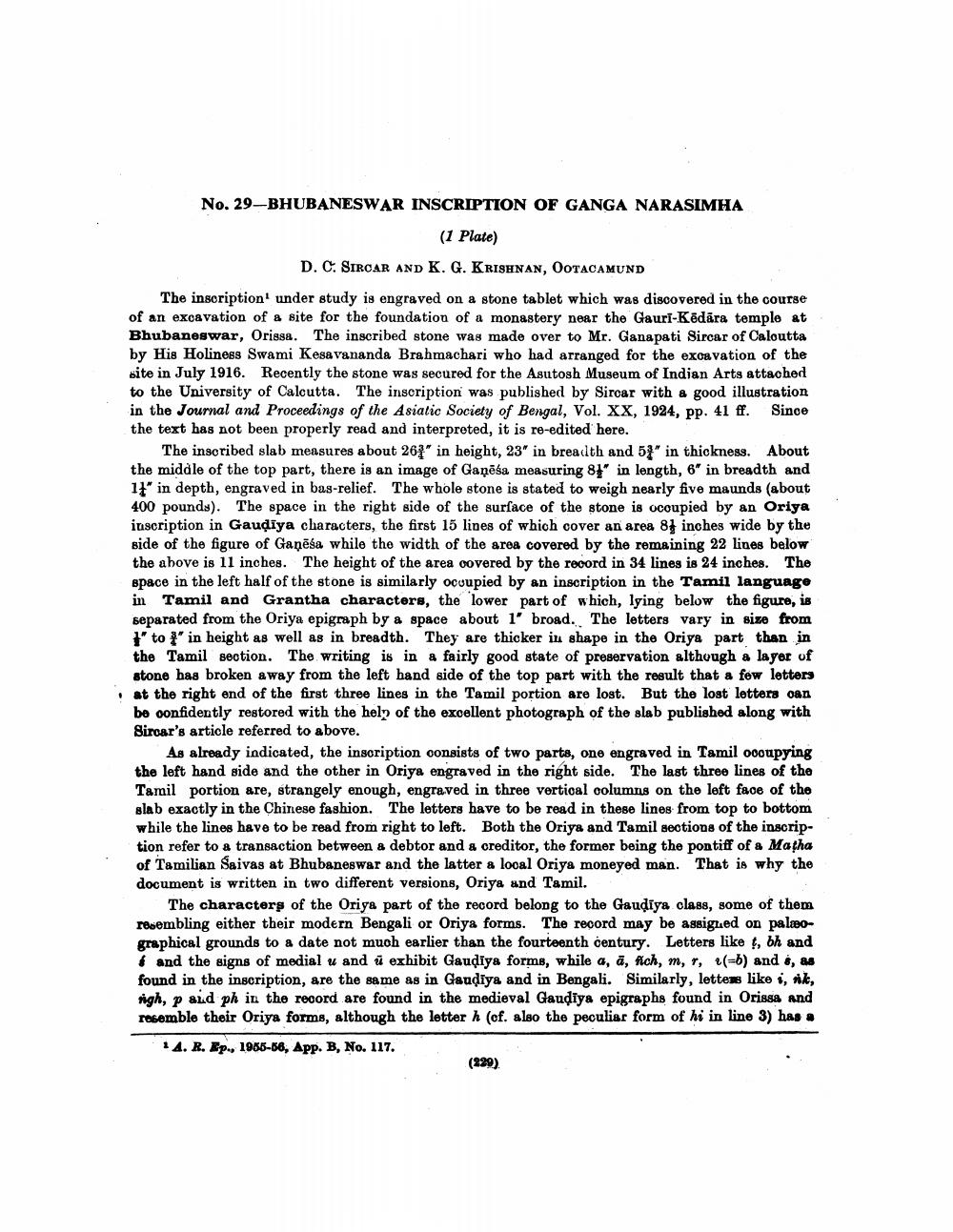________________
No. 29-BHUBANESWAR INSCRIPTION OF GANGA NARASIMHA
(1 Plate) D. C. SIROAR AND K. G. KRISHNAN, OOTACAMUND The inscription under study is engraved on a stone tablet which was discovered in the course of an excavation of a site for the foundation of a monastery near the Gauri-Kēdāra temple at Bhubaneswar, Orissa. The inscribed stone was made over to Mr. Ganapati Sircar of Caloutta by His Holiness Swami Kesavananda Brahmachari who had arranged for the excavation of the site in July 1916. Recently the stone was secured for the Asutosh Museum of Indian Arts attached to the University of Calcutta. The inscription was published by Sircar with a good illustration in the Journal and Proceedings of the Asiatic Society of Bengal, Vol. XX, 1924, pp. 41 ff. Since the text has not been properly read and interpreted, it is re-edited here.
The inscribed slab measures about 267" in height, 23" in breadth and 54" in thickness. About the middle of the top part, there is an image of Gaņēša measuring 81" in length, 6" in breadth and 17" in depth, engraved in bas-relief. The whole stone is stated to weigh nearly five maunds (about 400 pounds). The space in the right side of the surface of the stone is ocoupied by an Oriya inscription in Gaudīya characters, the first 15 lines of which cover an area 84 inches wide by the side of the figure of Gaņēsa while the width of the area covered by the remaining 22 lines below the above is 11 inches. The height of the area covered by the record in 34 lines is 24 inches. The space in the left half of the stone is similarly occupied by an inscription in the Tamil language in Tamil and Grantha characters, the lower part of which, lying below the figure, is separated from the Oriya epigraph by a space about 1' broad. The letters vary in size from 1" to " in height as well as in breadth. They are thicker in shape in the Oriya part than in the Tamil section. The writing is in a fairly good state of preservation although a layer of stone has broken away from the left hand side of the top part with the result that a few letters at the right end of the first three lines in the Tamil portion are lost. But the lost letters oan be confidently restored with the help of the excellent photograph of the slab published along with Siroar's article referred to above.
As already indicated, the inscription consists of two parts, one engraved in Tamil oocupying the left hand side and the other in Oriya engraved in the right side. The last three lines of the Tamil portion are, strangely enough, engraved in three vertical columns on the left face of the slab exactly in the Chinese fashion. The letters have to be read in these lines from top to bottom while the lines have to be read from right to left. Both the Oriya and Tamil sections of the inscription refer to a transaction between & debtor and & creditor, the former being the pontiff of a Matha of Tamilian Saivas at Bhubaneswar and the latter a local Oriya moneyed man. That is why the document is written in two different versions, Oriya and Tamil.
The characters of the Oriya part of the record belong to the Gaudiya class, some of them resembling either their modern Bengali or Oriya forms. The record may be assigned on palæographical grounds to a date not much earlier than the fourteenth century. Letters like , bh and $ and the signs of medial u and ū exhibit Gaudiya forms, while a, ā, fich, m, 1, (=b) and é, es found in the inscription, are the same as in Gaudiya and in Bengali. Similarly, lettem like i, rik, nigh, p and ph in the record are found in the medieval Gaudīya epigraphs found in Orissa and resemble their Oriya forms, although the letter h (cf. also the peculiar form of hi in line 3) has .
14. R. Ep., 1965-66, App. B, No. 117.
(229)




